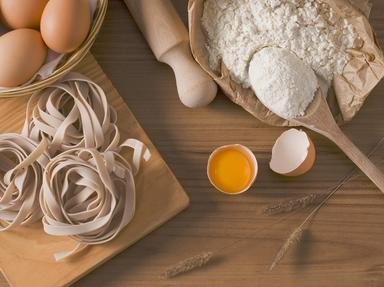Quiz Answer Key and Fun Facts
1. I've only just gotten back from the grocery store, and already I'm lost. I have two empty crisper drawers in my refrigerator, and bags of fruit and vegetables to store in them. How should I choose where to store each piece of produce?
2. It's two days before my dinner party, and I'm beginning to regret my decision to make my own pie crust. I've mixed together flour, sugar, butter, and salt, and what I've got is a coarse, crumbly mess. Nothing sticks together and I'm at a loss how I could roll it out into crust. What's wrong?
3. It's the night before my dinner party, and I'm working on the perfect sauce. My recipe looks mouth-watering, but the instructions are head-scratching. I have all the ingredients mixed together in a saucepan. How on Earth do I "reduce by 1/2"?
4. I've done my best with this sauce, but it's just not thickening properly. I know there's a trick to fix this. Which of these should I add to the sauce to thicken it?
5. It's the day of the dinner party, and I've just washed a whole head's worth of lettuce leaves for the salad. Unfortunately, I now have a huge amount of sopping wet lettuce, and I don't own a salad spinner. What's a good, simple way to dry my fresh salad greens before my guests arrive?
6. My next recipe calls for me to boil water. I was pretty sure I knew how to do that, but I'm really not sure about the difference between a "simmer" and a "rolling boil". Which is hotter?
7. I bought quite a few oranges for this recipe, but now I see that I'm supposed to add orange "zest". I like to think that I'm a zesty cook -- I certainly have a lot of enthusiasm and often sing show tunes off-key -- but it's hard to see how that would affect the flavor of the food. What am I supposed to do?
8. I'm feeling triumphant as I remove my roast beef from the oven; it smells incredible. I check the recipe for carving advice, and I see that I'm supposed to let it "rest for 15 minutes". What does this mean?
9. I'm just about ready to pop my brownies into the oven, but the batter is too tempting: I really want to do a taste test. (For the sake of my dinner guests, of course!) When the spoon is halfway to my mouth, I stop: I remember my mother always told me not to eat batter after I've added raw eggs. What is she worried about?
10. The brownies are baking, and the smell is incredible. The guests are licking their lips. What's a good way to tell whether the brownies are done?
Source: Author
CellarDoor
This quiz was reviewed by FunTrivia editor
Bruyere before going online.
Any errors found in FunTrivia content are routinely corrected through our feedback system.

